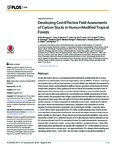Please use this identifier to cite or link to this item:
http://www.alice.cnptia.embrapa.br/alice/handle/doc/1022899| Title: | Developing cost-effective field assessments of carbon stocks in human-modified tropical forests. |
| Authors: | BERENGUER, E.  GARDNER, T. A.   FERREIRA, J.   ARAGÃO, L. E. O. C.   CAMARGO, P. B.   CERRI, C. E.   DURIGAN, M.   OLIVEIRA JUNIOR, R. C.   VIEIRA, I. C. G.   BARLOW, J.   |
| Affiliation: | Erika Berenguer, Lancaster University; Toby A. Gardner, Stockholm Environment Institute / International Institute for Sustainability; JOICE NUNES FERREIRA, CPATU; Luiz E. O. C. Aragão, University of Exeter / INPE; Plínio B. Camargo, CENA/USP; Carlos E. Cerri, ESALQ/USP; Mariana Durigan, ESALQ/USP; RAIMUNDO COSME DE OLIVEIRA JUNIOR, CPATU; Ima C. G. Vieira, MPEG; Jos Barlow, Lancaster University / MPEG. |
| Date Issued: | 2015 |
| Citation: | Plos One, v. 10, n. 8, e0133139, 2015. |
| Description: | Across the tropics, there is a growing financial investment in activities that aim to reduce emissions from deforestation and forest degradation, such as REDD+. However, most tropical countries lack on-the-ground capacity to conduct reliable and replicable assessments of forest carbon stocks, undermining their ability to secure long-term carbon finance for forest conservation programs. Clear guidance on how to reduce the monetary and time costs of field assessments of forest carbon can help tropical countries to overcome this capacity gap. Here we provide such guidance for cost-effective one-off field assessments of forest carbon stocks. We sampled a total of eight components from four different carbon pools (i.e. aboveground, dead wood, litter and soil) in 224 study plots distributed across two regions of eastern Amazon. For each component we estimated survey costs, contribution to total forest carbon stocks and sensitivity to disturbance. Sampling costs varied thirty-one-fold between the most expensive component, soil, and the least, leaf litter. Large live stems (10 cm DBH), which represented only 15% of the overall sampling costs, was by far the most important component to be assessed, as it stores the largest amount of carbon and is highly sensitive to disturbance. If large stems are not taxonomically identified, costs can be reduced by a further 51%, while incurring an error in aboveground carbon estimates of only 5% in primary forests, but 31% in secondary forests. For rapid assessments, necessary to help prioritize locations for carbon- conservation activities, sampling of stems 20cm DBH without taxonomic identification can predict with confidence (R 2 = 0.85) whether an area is relatively carbon-rich or carbon-poor ? an approach that is 74% cheaper than sampling and identifying all the stems 10cm DBH. We use these results to evaluate the reliability of forest carbon stock estimates provided by the IPCC and FAO when applied to human-modified forests, and to highlight areas where cost savings in carbon stock assessments could be most easily made. |
| Thesagro: | Floresta Tropical |
| Keywords: | Estoque de carbono |
| DOI: | 10.1371/journal.pone.0133139 |
| Type of Material: | Artigo de periódico |
| Access: | openAccess |
| Appears in Collections: | Artigo em periódico indexado (CPATU)  |
Files in This Item:
| File | Description | Size | Format | |
|---|---|---|---|---|
| ERIKAetaL2015.pdf | 1.81 MB | Adobe PDF |  View/Open |









